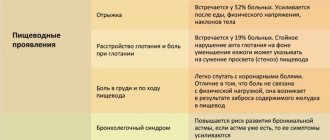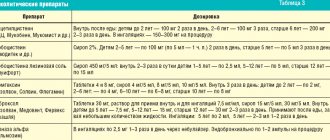Obstructive bronchitis is an inflammatory disease of the lower respiratory tract with damage to the bronchi. Bronchitis, in which the bronchi are narrowed, is called obstructive. Obstruction (literally this is a narrowing, overlap) - occurs under the influence of the inflammatory process in the walls of the bronchi and bronchioles, they thicken due to edema. Edema leads to concentration of sputum in the lumen of the bronchus. Sputum “clogs” the bronchi. Air passes through the bronchi with difficulty. The patient hears whistling and wheezing in the chest, as if bagpipes are being played inside.
In an adult patient it can be acute or chronic.
Acute obstructive bronchitis
This is an inflammation in the bronchi that begins quickly and is not preceded by several years of regular coughing. To the doctor’s question “How long have you been coughing?”, the patient will answer no more than a week.
The inflammatory process in the bronchi leads to swelling and irritation. A cough appears lasting no more than 3 weeks. In acute bronchitis, inflammation does not last long, and the structure of the bronchi will be completely restored after recovery.
In 80% of cases, acute obstructive bronchitis is caused by a viral infection of the upper respiratory tract. For example, influenza, parainfluenza, rhinovirus infection. Usually, people call all these pathogens, except influenza, colds. Less common causes of acute bronchitis are bacteria - mycoplasma or chlamydia pneumonia, the causative agent of whooping cough, staphylococcus, streptococcus and Haemophilus influenzae.
Chronic obstructive bronchitis
This is a chronic bronchial disease of an inflammatory nature. In this case, chronic (long-term) inflammation and swelling develop in the bronchial tree. Chronic inflammation and swelling narrow the lumen of the bronchi, which limits the flow of air into the lungs. The mechanism of obstruction coincides with the acute process that we described above. Against the background of obstruction, cough and shortness of breath intensify. Whistles and wheezing are heard in the chest. Sometimes wheezing and whistling can be heard even by people nearby. The patient has been suffering from cough for several years. The frequency of exacerbations of cough and other symptoms is two or three times a year, more than three weeks in a row.
Chronic bronchitis happens
- Obstructive
- Simple recurrent
- Asthmatic.
There are several causes of chronic obstructive bronchitis in adults. In the first place is the influence of external factors - tobacco smoking (active and passive). The second involves work related to inorganic dust (metallurgy, coal industry, etc.), the use of coal for home heating.
Other causes of this disease are infections. For example, previously suffered, poorly or lately treated bronchopulmonary diseases (consequences of untreated acute respiratory viral infections, pneumonia or childhood infections).
Asthmatic bronchitis is either undetected asthma or its onset, or pre-asthma.
Symptoms of obstructive bronchitis
The main and main symptom of any bronchitis is a cough.
There can be a cough without bronchitis - but there is no bronchitis without a cough!
In acute and chronic obstructive disease, sputum is coughed up during coughing. The cough is called wet or wet. Often a cough occurs without sputum - a “dry cough”.
The color of sputum when coughing is varied, from transparent to green-brown and sometimes with blood. Its color is given by bacteria that enter the bronchi during breathing and multiply.
For an acute process, light-colored sputum or yellow is more typical. For a chronic process, yellow-green, green and brown colors are more typical. This is due to chronic long-term inflammation and the presence of more aggressive microflora in the sputum.
Chronic asthmatic bronchitis is characterized by coughing attacks, sometimes with foamy or glassy sputum. A cough wakes the patient at night or in the morning. This cough interferes with exercise and when traveling on the subway. Against the background of a cough with asthmatic bronchitis, whistling sounds in the chest can be heard. The patient says “cat concert” in my chest!
A rise in temperature with these diseases is also not uncommon. This is due to the reasons that caused the development of the disease - these are respiratory viruses. An increase in temperature up to 39C, and with the flu, more than 39C are possible.
With exacerbation of obstructive bronchitis, the temperature rises slowly. At first it is small (low-grade fever), then it can unexpectedly increase and persist for a long time. Just during the period of recovery, the sputum changes from light to green or brown.
Shortness of breath, difficulty breathing
These symptoms are typical for any acute and chronic bronchitis complicated by obstruction, as well as for asthmatic bronchitis. These symptoms, plus wheezing and whistling, are associated with narrowing of the bronchi. The more pronounced the narrowing, the greater the cough, whistling and wheezing. When an infection enters the bronchial mucosa, it becomes inflamed and swollen, and its lumen decreases. The obstruction is aggravated by phlegm, which additionally blocks the movement of air during breathing and its speed sharply decreases. In this case, a person is forced to breathe more often to provide himself with oxygen. During these events, the sick person feels congestion and pain in the chest, burning, and wheezing.
In asthmatic bronchitis, obstruction occurs suddenly. This attack of suffocation causes panic in the sick person. The man says, “I had a choking attack!” Coughing up sputum during this attack is difficult, whistling and wheezing are heard in the chest.
Types of acute bronchitis
Depending on the nature of the inflammation, acute bronchitis can be:
- catarrhal (accompanied by an increased amount of bronchial mucus);
- fibrinous (with the formation of thick, sticky and difficult to separate sputum);
- mucopurulent/purulent (with copious amounts of mucus and discharge of pus);
- hemorrhagic (with streaks of blood in the sputum due to hemorrhages in the bronchial mucosa in severe forms of the disease).
According to the prevalence of the inflammatory process, acute bronchitis in adults is usually divided into focal, in which inflammation is localized in a limited area of the bronchi, and diffuse, covering most of the bronchial tree.
Treatment of obstructive bronchitis
The main tasks that must be solved in case of obstructive bronchitis
- The cough is relieved - it should not interfere with sleep, do household chores, irritate or disturb loved ones.
- It is necessary to restore the normal passage of air through the bronchi - reduce obstruction, improve expectoration of sputum.
- The infection must be destroyed.
- After recovery, prescribe a program to strengthen the immune system, conduct rehabilitation and give recommendations for vaccination against influenza and pneumonia.
Acute uncomplicated bronchitis can be cured without active treatment and without consequences. It is better for the patient not to go to work at this time, but to stay at home. Drink plenty of warm drinks and recovery usually occurs within 7 days.
Remember: Obstructive bronchitis carried on the “legs” can be complicated by pneumonia!
To treat obstruction, Berodual is used through a nebulizer. Expectorants are ineffective in acute cases. The decision on use is made by the doctor.
If the illness is accompanied by an increase in body temperature for more than 4 days, consult a pulmonologist. You may have pneumonia and need other medications.
With an exacerbation of a chronic obstructive process in the lungs, the task is different. Treatment is mandatory. To prevent the disease from progressing, active treatment is necessary. The causes of exacerbation of this disease are usually associated with a bacterial infection due to a cold or hypothermia. Treatment cannot be achieved without antibiotics. Modern expectorants will be required. Inhaled bronchodilators, especially through a nebulizer, will quickly reduce cough.
For asthmatic bronchitis, treatment is aimed at stopping a sudden narrowing of the lumen of the bronchi. The disease develops in response to inhalation of an allergen, chemicals with a strong odor, or organic dust. It is necessary to exclude the patient's contact with the irritant. Symptoms of this disease are coughing attacks, wheezing and whistling in the chest. The clinical picture is bright. For therapy, bronchi dilators, expectorants, and inhaled or intravenous steroids will be effective. Antibiotic therapy is rarely used.
Treatment methods
Medicines
Antibiotics are necessary to destroy bacteria that cause inflammation in the bronchi. Due to the high percentage of thoughtless use of antibiotics, the number of bacteria resistant to treatment has increased.
Don't self-medicate! Antibiotics must be prescribed by a doctor! In the medical scientific community, there are clear recommendations for prescribing antibiotics for regions of our country.
Antiviral drugs are necessary only for the treatment of influenza and bronchial inflammation accompanying this disease. Only two drugs with proven effectiveness against this virus are used - Oseltamivir and Zanamivir. These medications only treat influenza; they are useless for other acute respiratory viral infections.
Prescribing immune stimulants will not bring tangible results. Therefore, you will not find these drugs in the recommendations of medical societies.
In case of bronchial obstruction, drugs that resolve this obstruction are needed and effective - they dilate the bronchi.
Bronchiodilators (bronchodilators)
These medications are inhaled through nebulizers. These include Berodual, Atrovent and Salbutamol. The doctor prescribes treatment because they have side effects.
Steroid medications are effective for chronic asthmatic bronchitis. They are inhaled by inhalation or administered intravenously.
Expectorants - ambroxol, acetylcesteine or carbocesteine. The drugs can be used in the form of inhalations or parenterally (intravenously). The dosage and frequency of taking these medications is determined by a pulmonologist.
Inhalations
In the treatment of obstructive bronchitis, the role of inhalation is difficult to overestimate. Compressor nebulizers spray antibiotics, bronchodilators, expectorants, corticosteroids into microparticles and inject a therapeutic aerosol into the bronchi. The advantage of this delivery method is that the medicine is delivered precisely to the site of inflammation. Therefore, when treated through a nebulizer, it is possible to quickly reduce cough, normalize expectoration of sputum, and reduce its viscosity.
Massage
A massage that has proven to be very effective and simple to treat is cupping massage. Cupping massage came to us a long time ago from Chinese medicine. Irritation of the reflex zones of the skin of the back stimulates expectoration of mucus, reduces cough and leads to recovery.
“Ventum Vest Vibration” is a complex effect of vibration massage and pressure on the chest at the same time. The patient is put on a special vest into which air is pumped under pressure. By changing the frequency of air supply to the vest and the pressure on the chest, the immune system is activated. This occurs due to improved microcirculation in the affected bronchi. Improves lymph circulation and regeneration of damaged bronchial mucosa. If vibration massage is combined with inhalation of antibiotics and expectorant medications, their concentration in the affected bronchi will increase. The complex effect on the bronchi promotes rapid recovery without complications.
Exercise therapy and breathing exercises
At the stage of reducing the severity of the disease or exacerbation, exercise therapy and breathing exercises will increase expectoration of sputum and improve blood supply to the bronchi. This will reduce inflammation, shortness of breath and difficulty breathing. This effect is obtained by training the respiratory muscles. These muscles include the diaphragm, intercostal muscles and back muscles. The main audience for whom exercise therapy helps are patients with chronic smoker's cough and COPD.
Possible consequences and complications of obstructive bronchitis
If bronchial obstruction is treated incorrectly, serious complications are possible. Pneumonia comes first. Pneumonia is an acute infectious disease that leads to rapid death. The risk of developing pneumonia if treatment is not started in a timely manner or is incorrect is high. To prevent the development of pneumonia, the patient must consult a pulmonologist. The doctor will be able to diagnose and rule out pneumonia. Perhaps he will prescribe a course of antibiotics without waiting for pneumonia to develop. If your body temperature does not decrease for more than 3-4 days or constantly increases, your cough intensifies and purulent or brown sputum appears, then there is a very high probability that you have pneumonia.
Against the background of bronchitis, a possible complication is pneumothorax - a rupture of the pleura due to a strong and intense cough. This is a resuscitation situation. Pneumothorax is observed in patients with bullous transformation, COPD, but cases of pneumothorax due to prolonged cough are common. Due to long-term obstruction and inflammation, the lung tissue loses its elasticity and becomes rigid. Lung tissue is easily damaged by coughing. Therefore, if symptoms such as sudden shortness of breath and chest pain appear, you should urgently consult a pulmonologist.
Frequent exacerbations of obstructive bronchitis lead to the emergence or progression of COPD, a disease that leads to the development of respiratory failure and death.
Prevention
Prevention of an acute obstructive process in the bronchi is identical to the prevention of influenza and ARVI - these are annual, seasonal flu vaccinations. During the onset of cold weather in the off-season, it is necessary to avoid hypothermia and contact with already sick patients.
To prevent exacerbations of chronic obstructive bronchial disease, first of all, eliminate the external factors that cause it - tobacco smoking, dust in enterprises, work in a mine. Flu vaccination is carried out annually. For patients with chronic obstructive bronchitis, vaccination against pneumonia is carried out. It is carried out once every 5 years.
Treatment at special respiratory resorts is considered an important element of prevention. They exist in our country - Crimea. In Germany (Bad Reichenhall), southern coast of France, coast of Italy. The main task of a patient at a resort is active physical exercise in the fresh air.
Causes of acute bronchitis
The cause of acute bronchitis in adults in the vast majority of cases is an infection: most often viral, less often bacterial, and occasionally fungal. In addition, the disease can be of an allergic nature (due to a high concentration of allergen in the air), develop in the presence of inflammation of the adenoids or chronic foci of infection in the paranasal sinuses, against the background of tonsillitis.
It is worth considering factors that reduce local immunity and contribute to the occurrence of the disease:
- hypothermia;
- smoking;
- alcohol abuse;
- hereditary diseases;
- chronic pathology of the nasopharynx;
- unfavorable climate (dampness, cold);
- air polluted with dust or toxic impurities.










